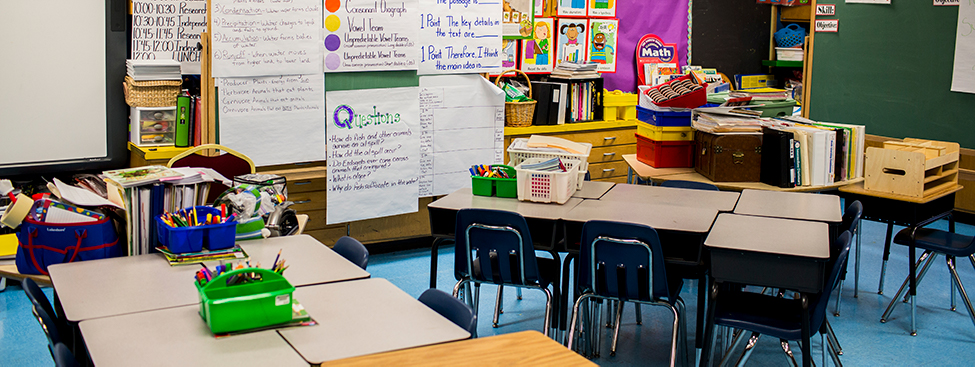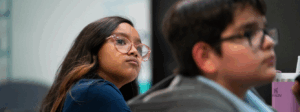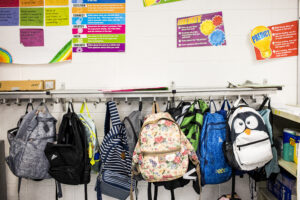In the summer and fall of 2021, TNTP partnered with Stanford University’s Center for Understanding Language on a training program for fourth- through eighth-grade math teachers in three California school systems that serve high percentages of multilingual learners, the fastest-growing demographic in U.S. public schools. The training was modeled on TNTP’s successful Good to Great teacher development program, and provided coaching on language instructional practices while also giving teachers time to apply what they learned with students.
In surveys, 90 percent of teachers agreed or strongly agreed that their teaching improved as a result of the training and 83 percent showed growth in core instructional skills. Just as importantly, many teachers came away with higher expectations for what multilingual students can achieve. We spoke with three of the participating educators about their experience and the impact it had in their classrooms.
To learn more about the training described in this post and access free resources to help school and system leaders implement this approach, download our new resource, More Than Right Answers: Math Instruction for Multilingual Learners.
Why did your district decide to participate in the Multilingual Learner Good to Great training?
Araceli Mendez, Mathematics Coordinator, Pajaro Valley Unified School District: The program targets mathematics instruction with an emphasis on multilingual learners, which are both areas of growth in our district. First, we wanted to see an increase in student conversation in the classroom versus teacher talk. Second, we were focused on equipping our teachers with high-leverage instructional strategies to support multilingual students during math instruction, as mathematics is often taught in isolation from language development. And the third need that we wanted to address was developing a vision and understanding for strong math instruction, not only with our teachers but also with our school leaders.
What about the Multilingual Learner Good to Great training resonated with you?
Araceli: I appreciated the observation feedback cycle. Even though the process was virtual, we could tell that it was well received because the teachers were willing to shift behaviors and try new things the very next day, based on feedback that they were getting from their coach.
Juan Gonzalez, Teacher, Fifth Grade, Pajaro Valley Unified School District: Being provided language-focused feedback every day from the TNTP coaches and other grade-level teachers made me work harder, to be honest. Planning in a small cohort helped me focus on the strategies that I was going to be using for a particular lesson. And when I came to class and taught the lesson, it made it much easier.
Nicole Thompson, Teacher, Fourth Grade, Pajaro Valley Unified School District: My biggest takeaway from the training was to not focus on, “Did you get the right answer?” Even if it’s the wrong answer, there’s no reason why I shouldn’t celebrate students’ reasoning for how they approach the problem to begin with. That was an eye opener for me and also helps the students feel more confident in their learning. For example, the Three Reads Routine structure is an amazing way to break up a math problem and make sure the students understand what’s going on. We’re just asking, “What’s happening in this problem?” And then you focus on the numbers and what they actually mean. And finally, you get to the question itself–what kind of math do we need to use? What is your answer actually going to be? I had noticed that my students might be able to use mental math and get an answer, but they couldn’t always tell me what that answer meant.
Would you say that you saw your students grow as you implemented these different strategies?
Araceli: In our continued classroom visits we’re starting to see that shift from teacher talk to student talk, and an increase in student voice during math instruction, instead of the teacher just providing answers or asking yes-no questions.
Juan: At the beginning I noticed kids were like, “I really don’t want to do math. I don’t want to do decimals. I don’t want to multiply. Why are you making me do this?” But students are becoming a little more comfortable, more confident, more willing to participate in our class discussions. I hear a lot of math terminology being used as a result of the language supports I’m providing. Some of them are even leading conversations, like, “I heard you say this, but I think this is the way it’s supposed to be solved because x and x goes with y plus y.” Students are making a lot of progress!
Nicole: They’re putting more thought into their work and not just rushing through and memorizing things saying, “Okay, I’m done.” Learning how to explain their math reasoning is even helping students in language arts, where they need to reinforce their opinion about a text with evidence. And so I think they’re starting to understand that math isn’t just about doing the math–it’s comprehending it as well.
We talk a lot about how mistakes are an opportunity to grow and to be a good partner, to be a good friend. Today I had to shout out this pair that was in front of the class. One of them got the wrong answer, but the other one did a great job explaining to her why that happened–she had misread the part of the question that asked for “in all.” And then they worked together to solve the problem. I think that’s a really good shift in mindset.
One teacher participant shared that, “Multilingual Learner Good to Great showed me that even if my students were coming in below grade level, after learning in a pandemic for a year and a half, they can do grade-level math.” Does that resonate with you?
Juan: I definitely agree with that statement. It doesn’t matter where students are academically–they are all fully capable learners. They need to be given the opportunity to grow and struggle a little bit, but they also need guidance. We want them to have that self-discovery, so they can feel empowered and proud of themselves when they find their way.
Nicole: I love that quote. Our students are capable of so much and it’s our role as teachers to help facilitate that and to give them the strategies and the support that they need to succeed regardless of any language barriers. I’m really happy that this program really stressed the importance of that to me.








